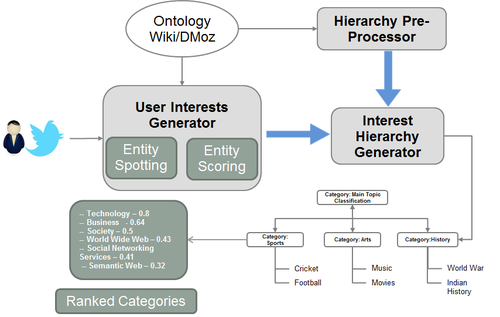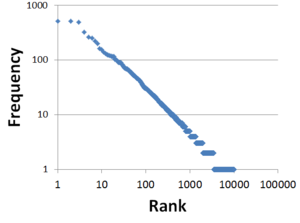Difference between revisions of "Hierarchical Interest Graph"
(→Approach) |
(→Evaluation) |
||
| Line 12: | Line 12: | ||
=Evaluation= | =Evaluation= | ||
| + | The evaluation was done with three variations of spreading activation theory used in our approach. The three activation functions are as follows; | ||
| + | * Bell: Normalizes the propagated value based on the number of nodes in the next level of specificity. | ||
| + | * Bell Log: Builds upon <i>Bell</i> by reducing the impact with Log based reduction. | ||
| + | * Priority Intersect: Builds upon <i>Bell Log</i> with prioritizing the most suitable categories and boosting the entity-intersecting nodes. | ||
| + | |||
| + | In order to evaluate our system we conducted a users study. Attracting participants for a user study is difficult. Although 40 people agreed to perform the user study, 37 of those responded. | ||
| + | |||
| + | == == | ||
== Distribution of Entities from the User Study == | == Distribution of Entities from the User Study == | ||
[[image:Entity-distribution.png|left|thumb|300px|Distribution of Entities from User Study]] | [[image:Entity-distribution.png|left|thumb|300px|Distribution of Entities from User Study]] | ||
| − | |||
| − | |||
=References= | =References= | ||
=People= | =People= | ||
Revision as of 22:14, 13 October 2013
Contents
Abstact
Industry and researchers have identified numerous ways to monetize microblogs for personalization and recommendation. A common challenge across these different works is identification of user interests. Although techniques have been developed to address this challenge, a flexible approach that spans multiple levels of granularity in user interests has not been forthcoming.
In this work, we focus on exploiting hierarchical semantics of concepts to infer richer user interests expressed as Hierarchical Interest Graph. To create such graphs, we utilize user's Twitter data to first ground potential user interests to structured background knowledge such as Wikipedia Category Graph. We then use an adaptation of spreading activation theory to assign user interest score (or weights) to each category in the hierarchy. The Hierarchical Interest Graph not only comprises of user's explicitly mentioned interests determined from Twitter, but also their implicit interest categories inferred from the background knowledge source. We demonstrate the effectiveness of our approach through a user study which shows an average of approximately eight of the top ten weighted categories in the graph being relevant to a given user's interests.
Approach
The goal of our approach is to construct a Hierarchical Interest Graph (HIG) for a Twitter user. To accomplish this our system performs the following steps:
- Hierarchy Pre-processor converts the Wikipedia Category Graph (WCG) into a hierarchy
- User Interests Generator spots and scores the Primitive Interests from tweets of a user.
- Interest Hierarchy Generator maps the scored Primitive Interests to Wikipedia Hierarchy to infer the HIG of the user.
Step 1 of our approach is performed if and when there are updates to Wikipedia Category Graph. Step 2 and 3 are performed for the set of tweets of each user to generate the corresponding HIG. Below Figure illustrates our approach.
Evaluation
The evaluation was done with three variations of spreading activation theory used in our approach. The three activation functions are as follows;
- Bell: Normalizes the propagated value based on the number of nodes in the next level of specificity.
- Bell Log: Builds upon Bell by reducing the impact with Log based reduction.
- Priority Intersect: Builds upon Bell Log with prioritizing the most suitable categories and boosting the entity-intersecting nodes.
In order to evaluate our system we conducted a users study. Attracting participants for a user study is difficult. Although 40 people agreed to perform the user study, 37 of those responded.

